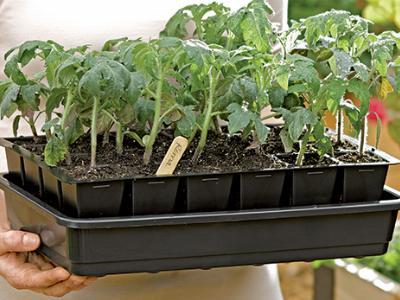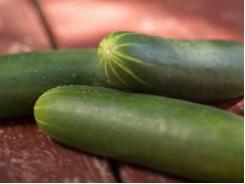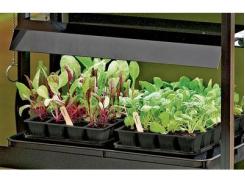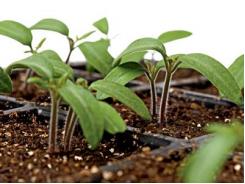How To Start Seeds

A comprehensive guide to growing vegetables and flowers from seed
There are many ways to start seeds, but a seed-starting system, such as the GrowEase Seed Starting Kit ensures good results.
Growing plants from seed is a great way to start gardening earlier in the season. With the right light and some simple equipment, it's easy to grow from seed to harvest.
Marigold growing among vegetables
Keep it simple
Because each plant has unique seed-starting requirements, it helps to start small by growing just a few varieties. Some seeds — such as tomatoes and marigolds — are especially easy to start indoors. If you're a beginner, choose those first, and then move on to more fussy seeds, such as petunias.
Other good choices for beginners:
- Basil
- Zinnia
- Coleus
- Nasturtium
- Cosmos
Make sure you have lots of light
All seedlings require a considerable amount of light, so make sure you have a sunny, south-facing window. If seedlings don't get enough light, they will be leggy and weak.
If you don't have a sunny, south-facing window, invest in grow lights and a timer . It's the best way to ensure consistent, abundant light. Set the timer for 15 hours a day, water regularly and you're sure to get great results
Learn more in the article Gardening Under Lights.
Get the timing right
The goal with seed starting is to have your seedlings ready to go outside when the weather is favorable. Start by looking at the seed packet, which should tell you when to start seeds inside. Usually, it will say something like, "Plant inside six to eight weeks before last frost."
Some types of vegetables, such as beans and squash, are best started outdoors. There is little benefit to growing them indoors because they germinate and grow quickly. Some flowers, such as poppies, are best planted outdoors, too. These seeds are usually marked "direct sow".
For more on timing, read the article When to Start Your Seeds.
Six Steps, from Seed to Garden
1. Find the right containers
You can start seeds in almost any type of container, as long as it's at least 2-3 " deep and has some drainage holes. If you are the DIY type, you might want to grow seedlings in yogurt cups, milk cartons or paper cups. I prefer the convenience of trays that are made especially for seed starting. It's easy to fill the trays, the watering system ensures consistent moisture and I can move them easily.
2. Prepare the "potting soil"
Choose potting soil that's made for growing seedlings. Do not use soil from your garden or re-use potting soil from your houseplants. Start with a fresh, sterile mix that will ensure healthy, disease-free seedlings.
Before filling your containers, use a bucket or tub to moisten the planting mix. The goal is to get it moist but not sopping wet; crumbly, not gloppy. Fill the containers and pack the soil firmly to eliminate gaps.
Remember that most mixes contain few, if any, nutrients, so you'll need to feed the seedlings with liquid fertilizer a few weeks after they germinate, and continue until you transplant them into the garden.
3. Start planting
Check the seed packet to see how deep you should plant your seeds. Some of the small ones can be sprinkled right on the soil surface. Larger seeds will need to be buried. For insurance, I plant two seeds per cell (or pot). If both seeds germinate, I snip one and let the other grow. It's helpful to make a couple divots in each pot to accommodate the seeds. After you've dropped a seed in each divot, you can go back and cover the seeds.
Moisten the newly planted seeds with a mister or a small watering can. To speed germination, cover the pots with plastic wrap or a plastic dome that fits over the seed-starting tray. This helps keep the seeds moist before they germinate. When you see the first signs of green, remove the cover.
4. Water, feed, repeat
As the seedlings grow, use a mister or a small watering can to keep the soil moist but not soggy. Let the soil dry slightly between waterings. Set up a fan to ensure good air movement and prevent disease. I use a fan that's plugged into the same timer as my grow lights. Remember to feed the seedlings regularly with liquid fertilizer, mixed at the rate recommended on the package.
5. Light, light, light!
Seedlings need a lot of light. If you're growing in a window, choose a south-facing exposure. Rotate the pots regularly to keep plants from leaning into the light. If you're growing under lights, adjust them so they're just a few inches above the tops of the seedlings. Set the lights on a timer for 15 hours a day. Keep in mind that seedlings need darkness, too, so they can rest. As the seedlings grow taller, raise the lights.
6. Move seedlings outdoors gradually
It's not a good idea to move your seedlings directly from the protected environment of your home into the garden. You've been coddling these seedlings for weeks, so they need a gradual transition to the great outdoors. The process is called hardening off. About a week before you plan to set the seedlings into the garden, place them in a protected spot outdoors (partly shaded, out of the wind) for a few hours, bringing them in at night. Gradually, over the course of a week or 10 days, expose them to more and more sunshine and wind. A cold frame is a great place to harden off plants.
Troubleshooting
Only one-quarter of my seeds germinated. What went wrong? There are a number of factors that affect seed germination. Check the seed packet to determine if all the requirements for temperature and light were met. If the soil was cold and excessively wet, the seeds may have rotted. Dig up one of the seeds and examine it. If it is swollen and soft, the seed has rotted and you will need to start over. If the soil was too dry, the seeds may not have germinated or may have dried up before their roots could take hold. If the seeds were old, they may no longer be viable. Try again and be sure to provide consistent moisture.

From our Garden Lab: The seedlings on the right were grown on a windowsill. You can see how the stems are long and spindly, with tiny leaves. On the left are seedlings grown under lights.
My seedlings are spindly. What can I do? Plants grow tall and leggy when they do not receive enough light. Use grow lights to ensure that they receive 15 hours of bright light each day. Warm temperatures can also stimulate leggy growth. Try lowering the room temperature and reducing the amount of fertilizer you apply. For more on this topic, see the article Growing Under Lights.
The leaves on my tomatoes are starting to look purple along the veins and on the underside of the leaves. What's happening? Purple leaves are an indication that the plant is not receiving enough phosphorus. If you have been using half-strength fertilizer for the first three to four weeks of the seedling's life, it may be time to increase the fertilizer to full strength. The phosphorus content (the middle number on the fertilizer analysis) should be at least 3.
My seedlings were growing well until all of a sudden they toppled over at the base. What happened? When the stems of young seedlings become withered and topple over, they have probably been killed by a soil-borne fungus called "damping off." This fungus is difficult to eradicate once it is present in the soil, but you can avoid it by using a sterile, soilless growing medium , and by providing good air circulation.
Mold is growing on the top of the soil surface. It doesn't appear to be hurting my plants, but should I be concerned? Mold is an indication that the growing medium is too wet. It will not harm your plants as long as you take action. Withhold water for a few days and try to increase air circulation around the containers by using a small fan. You can also scrape off some of the mold or try transplanting the seedlings into fresh soil.
Tools

Phối trộn thức ăn chăn nuôi

Pha dung dịch thủy canh

Định mức cho tôm ăn

Phối trộn phân bón NPK

Xác định tỷ lệ tôm sống

Chuyển đổi đơn vị phân bón

Xác định công suất sục khí

Chuyển đổi đơn vị tôm

Tính diện tích nhà kính

Tính thể tích ao




 Vegetable Gardening For Beginners
Vegetable Gardening For Beginners  When To Start Your Seeds
When To Start Your Seeds